Well-financed outsiders from France and California are buying up vineyards and wineries in the Willamette Valley.
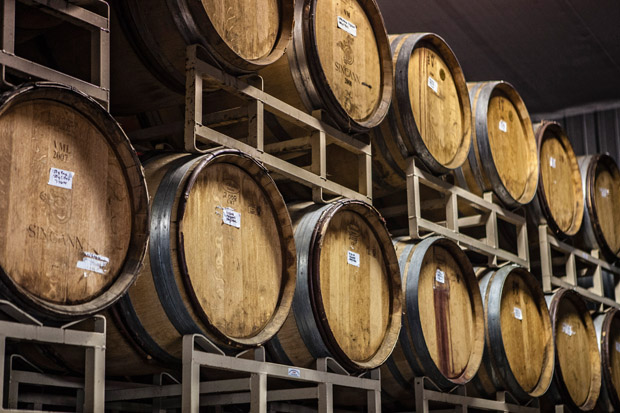
On December 18, 2012, a massive windstorm blew through the Willamette Valley, causing severe roof damage to Kevin and Carla Chambers’ triple-wide mobile home just outside Newberg. “We had a waterfall in our house,” says Kevin, a vineyard manager who has worked in the Oregon wine industry for 35 years. “My wife and I looked at each other and said, ‘Obviously, we’ll have to do something about our living situation.’”
Back in 1989, the couple had bought a 32-acre property called Resonance, knowing that it was an exceptional site for growing pinot noir grapes. In the hands of local winemakers such as Peter Rosback at Sineann and Brian Marcy at Big Table Farm, Resonance fruit consistently made some of the best wines coming out of the valley, according to reviews in respected publications such as International Wine Cellar.
So it was with mixed emotions that Kevin and wife Carla decided to part with their property, selling it to the illustrious Burgundian winery Maison Louis Jadot. (The sale price was not disclosed, but insiders say it broke a record for per-acre price for a vineyard in Oregon.) Setting the international wine world atwitter, legendary Jadot winemaker Jacques Lardière came out of retirement to run the company’s Oregon outpost.
“It was hard to let go of Resonance,” Kevin says. But with the money they made from the sale, the Chambers were able to buy their first stick-built home — on a Christmas tree farm in the Eola-Amity Hills.
While modest in size — the property has 20 acres of planted vineyards — this Resonance sale is just one of a half dozen recent Willamette Valley real estate transactions that signals the region’s growing appeal on the international wine stage. This trend is being driven by a handful of factors: the drought in California, comparatively low land prices in the Willamette Valley and the aging of Oregon winemakers. But the central reason large, out-of-state players are investing in the Willamette Valley is consumer demand for Oregon pinot noir.
“There are not so many places outside Burgundy where pinot noir is known, and Oregon is one of them,” says Thibault Gagey, deputy general manager of Jadot, referring to the company’s decision to purchase its first vineyard outside of Burgundy in Yamhill-Carlton.
The Oregon wine industry has come a long way since 1965, when David and Diana Lett planted the first pinot noir cuttings in the Willamette Valley. The region achieved international acclaim in 1979 — when the Letts’ Eyrie pinot noir came in third place at a blind tasting of some of the world’s finest pinots in Paris. Burgundian wine producer Robert Drouhin was so impressed that he sent his daughter Véronique to Oregon to work the 1986 harvest with three Oregon winemakers. In 1987 Drouhin purchased 225 acres in the Dundee Hills, making Domaine Drouhin the first French firm to plant roots in the Willamette Valley.
Today there are around 600 wineries in Oregon. Three-fourths are still small by industry standards, producing fewer than 5,000 cases per year. A 2011 economic impact study valued the industry at $2.7 billion, but that figure is larger today, says Michelle Kaufmann at the Oregon Wine Board. “We’ve had record harvests since then, additional wineries popping up, and all this outside investment.”
By all accounts, the buying spree over the past two years is unprecedented. A year ago, Jackson Family Wines in Santa Rosa, California, bought 320 acres of vineyards in both the Eola-Amity Hills and the Yamhill-Carlton wine regions. In May 2013, Seattle’s Precept Wine, the largest privately owned wine company in the Northwest, bought the 30-acre Yamhela Vineyard. In April California-based Foley Family Wines acquired the Four Graces, which included 54 acres in the Dundee Hills and 40 acres in Yamhill-Carlton. Sommelier Larry Stone, former president of Evening Land Vineyards, just bought a vineyard in the Eola-Amity Hills and has planted 66 acres.
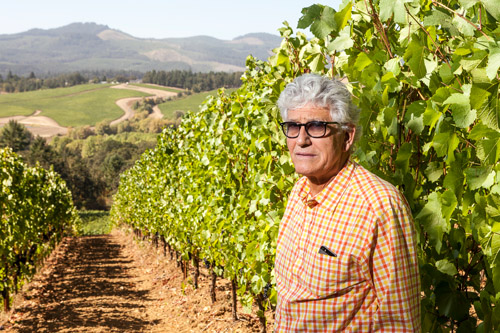 |
| Jadot winemaker Jacques Lardière in the Resonance vineyard |
In all cases, neither side would disclose sale prices. But Peter Bouman, the broker at Oregon Vineyard Property, says the recent range for planted acres has been between $45,000 and $60,000 an acre.
Private equity firms such as San Francisco-based Bacchus Capital Management have also made strategic investments in the valley. Bacchus has made debt and equity investments in Wine by Joe, one of the largest producers in Oregon, and in May they bought Panther Creek winery outright.
Then there are the outsiders who have been working and living here so long they are practically insiders. Domaine Drouhin staked its claim here 27 years ago. Late last year, they purchased the 122-acre Roserock Vineyard in the Eola-Amity Hills. This past March, pioneering Oregon winery Elk Cove bought the Goodrich Road Vineyard in Yamhill-Carlton, which has 21 acres of vineyard.
Wine-industry brokers say this is just the beginning. “The French are coming. And they’re going to keep coming,” says Bouman, who conducted the Jadot sale.
How is this frenzied activity impacting Oregon’s hundreds of small-scale winemakers? A tight-knit group — everybody here seems to know everybody else, and gossip travels fast — most winemakers interviewed for this article share the attitude of “a rising tide raises all ships.”
However, some also expressed anxiety about skyrocketing grape and real estate prices. Many winemakers don’t actually own their own vineyards, so these “land grabs” are taking thousands of acres of grapes off the market, causing a dearth of grapes and record-high prices. The average price for Oregon pinot noir grapes in 2012 was $2,738 per ton, a 20.6% increase over 2011. And though that figure dipped slightly in 2013, the price of North Willamette Valley pinot noir grapes — the most highly prized — were $2,819 a ton. As a result, winemakers who don’t own their own vineyards are being priced out of top-quality grapes.
Oregonians have long been sensitive to encroachment from outsiders. Today’s influx of well-heeled vintners from California, France and elsewhere echoes the recent migration of professionals from cities like Brooklyn and L.A. to Portland. Will the vintners, like these urban escapees seeking a greener, more balanced lifestyle, drive up real estate prices — not to mention bottle prices — in the Willamette Valley?
A perfect storm of factors has led to this moment. First, a bunch of vineyard owners are reaching mature vintages themselves — and are ready to cash in. “They’re 60, pushing 70, and need to retire,” notes Bouman, who has four vineyards for sale, including the 70-acre Eola Springs Vineyard in the Eola-Amity Hills, listed at $2.5 million.
The historic drought in California is also much worse than winemakers anticipated. Every week headlines proclaim record-low rainfalls. As a result, vineyard managers are predicting extremely low yields.
 |
| Kevin and Carla Chambers sold Resonance to Jadot in 2013 |
“There’s no question anymore that the water issues in California are driving people north,” says Bouman. “I got a call the other day from a guy who is growing 500 acres in Lodi [in California’s Sierra Foothills] and basically is considering selling everything lock, stock and barrel and moving up here because of the drought. I’m getting an increasing number of calls like that.”
Few California buyers will publicly admit that the drought is one of their reasons for coming to the Willamette Valley, where the average rainfall is 35 inches a year. Marcus Goodfellow, owner and winemaker at Matello Wines, thinks that’s intentional. “That’s the game changer that no one talks about,” says Goodfellow. “What happens when California can no longer be California?”
When people ask Hugh Reimers, chief operating officer of Jackson Family Wines, why the company bought land in Oregon, he jokes, “Well, we were worried about global warming.” But Reimers, who grew up in Australia, says that’s tongue in cheek. The wine behemoth — which owns vineyards in Chile, Australia, France and Italy — had been eyeing Oregon for a long time, he says. So when the California Public Employees’ Retirement System (CalPERS) decided to sell off its vineyard investments, putting more than 500 vineyard acres in Oregon on the market in 2013, Jackson Family Wines snapped two of them up.
In addition to buying Gran Moraine in Yamhill-Carlton and Zena Crown in west Salem, the company bought Soléna Estate, a 35-acre vineyard, and Maple Grove, a big tract of land near Monmouth, where the company is planting 100 acres of vineyard.
“There are few places in the world where you can grow world-class pinot noir,” Reimers says, explaining why the company purchased 1,380 land acres in Oregon. But it didn’t hurt that real estate here is far cheaper than in other fashionable wine-growing regions. “And I think Willamette Valley vineyard prices will continue to appreciate. “says Reimers. “So it was a good real estate investment for us, as well as investment in quality.” While prime vineyards in Napa can go for as high as $300,000 an acre, $50,000 an acre is more typical in the Willamette Valley.
According to Gagey, Jadot’s purchase of Resonance Vineyard had more to do with the valley’s high-quality pinot noir than low land prices. “We went there two times, we tried the wines, we liked the wines,” says Gagey of his visits to Resonance. They also loved the specific property, on an east-west ridge in Yamill-Carlton, because it was dryfarmed (not irrigated) and own-rooted. (That is, old vines, not grafted rootstock.) “Those two things, we are very interested in,” says Gagey. Though small in terms of acreage, this purchase represents a big shift for the 160-year-old winery, which until now has only had acreage in Burgundy. They expect to release 2,000 to 2,500 cases of their first Oregon vintage (from 2013) in 2016.
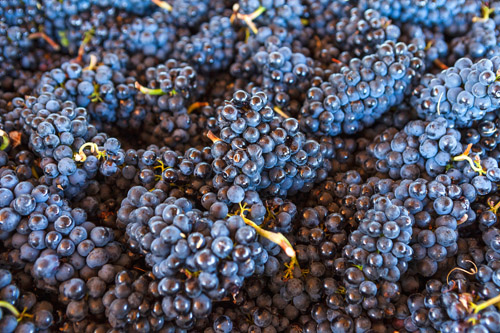 Many local winemakers are flattered by this newfound passion for Willamette Valley pinot — and think investments by well-financed outsiders are a good thing.
Many local winemakers are flattered by this newfound passion for Willamette Valley pinot — and think investments by well-financed outsiders are a good thing.
“I’ve gotta be honest: The vast majority of the last 40 years has been getting our pinot on the map,” says Goodfellow, who has been making wine in Oregon since 2002. “Seeing big players like Jackson Family Wines purchase here validates the Willamette Valley as a region.”
Goodfellow, who purchases all the fruit he uses to produce 4,000 cases of wine a year, was dismayed to learn that one of his regular fruit sources — Bishop Creek Cellars — was on the market. “I’ve been producing wine from that vineyard since 2005,” he says wistfully.
But the general sentiment amongst Oregon winemakers, he says, is that these recent acquisitions may turn out to be a great boon for the region. “What’s happening now is proof that we have a grown-up wine region. We’re not the little brother to Burgundy anymore.”
Thirty-five-year-old urban winemaker Thomas Monroe at Division Winemaking Company in Southeast Portland relies on other growers for all of his fruit too. Despite being pushed out of three vineyards — and being turned down by another — Monroe, too, is sanguine about the influx of out-of-state winemakers. “It causes some short-term supply chain issues,” he says. “But ultimately, it’s an accolade — these people believe in Oregon. They have a lot of money behind them. They wouldn’t do that if they didn’t know that they would be able to make a high-quality product from this state.”
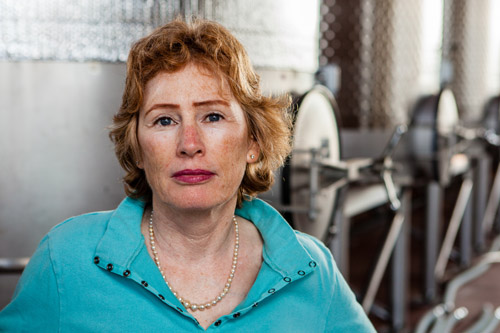 |
| Oregon winemaker Eugenia Keegan |
One thing that’s engendered good will is that most of these newcomers have hired well-regarded Oregon winemakers. “Jackson Family Wines has employed Eugenia Keegan, who is extraordinarily well-loved in Oregon,” says Goodfellow. (Keegan, who is general manager at JFW, came from Four Graces in Dundee.) JFW also hired Tony Rynders; Precept hired Sarah Cabot. Some companies have even continued allowing local winemakers to buy grapes from their new properties — at least for the time being. Lynn Penner-Ash, for one, was able to negotiate a long-term deal with JFW that allows her to keep buying grapes from one particular 3.5-acre block of the Zena Crown Vineyard. “We have worked with this site since its first crop in 2007 and have consistently done well in the press with the wines we produce from there,” says Penner-Ash. “It would be difficult to see our block go.”
But underneath this upbeat acceptance of outsiders lies a barely articulated wariness. The Willamette Valley has always positioned itself as the anti-Napa. Even today, tasting fees — if they exist — are minimal. And though there are plenty of fancy LEED-certified tasting rooms, there are just as many unheated sheds or scrappy living rooms where wine lovers taste by appointment only. Most established winemakers also have a philosophical commitment to keeping bottle prices affordable.
This presents a conundrum. One of the repercussions of these recent land grabs is that grape prices are through the roof. “In my 35 years in this industry, I have never seen grape prices higher than they are now,” says Kevin Chambers. And grapes from acclaimed sites like Shea Vineyards go for as much as $4,500 a ton.
Though of course a boon for vineyard owners, these higher grape prices mean wineries that don’t own their own vineyards are having to scramble to find new grape sources, or pay a premium.
Monroe and his wife, Kate, have felt the pinch of these price increases. Though they haven’t been directly impacted by the recent vineyard sales (yet), they have been priced out of a few of their regular fruit sources. Just four years ago, when he made his first Oregon vintage, Monroe was paying in the mid-$2,000 range per ton for pinot noir grapes. This year he’s paying well over $3,000.
Despite rising grape prices, Ken Pahlow, winemaker at Walter Scott Wines in the Eola-Amity Hills, hews to a $45 per bottle threshold. “I always felt that if Russ Raney [former winemaker at Evesham Wood] — after 25 years in the business — if his most expensive wine was $44, how could I come in and charge more?” Pahlow says about Raney’s Cuvée J, which Pahlow considers to be one of the best wines in the valley.
“Nearly 40% of our production is Willamette Valley pinot noir or chardonnay that retails for $23,” he says. “Once you get over $40, $45, you’re not going to sell a lot of wine to the Portland market.”
The newcomers — Jackson Family Wines, Jadot and Precept — are undeterred. Jackson’s entry-level Oregon Pinot under the La Crema label, released in April, retails for $35, and the company’s Gran Moraine Yamhill-Carlton Pinot is $45. These higher price points are strategic. “We didn’t go up there to try to bring the market down,” says COO Reimers. “If anything, we went up there because we saw an opportunity to elevate the market and the industry by producing wines at much higher price points.”
Elevating the market is a lofty goal. Elevating land prices … not so much. Peter Rosback at Sineann Winery — who purchases 100% of his grapes — says he was hurt by Kevin Chambers’ sale of Resonance Vineyard. “Kevin — he’s a friend of mine — he needed the money, but that pinot noir was really special,” says Rosback. He’s also frustrated by “California carpetbaggers” who have snapped up prime vineyards in the Willamette Valley.
“It’s annoyed me and friends of mine mostly because we aren’t rich,” says Rosback. “Winemaking is not a highly profitable enterprise. Our margins are low, and we have competition from all over the world.”
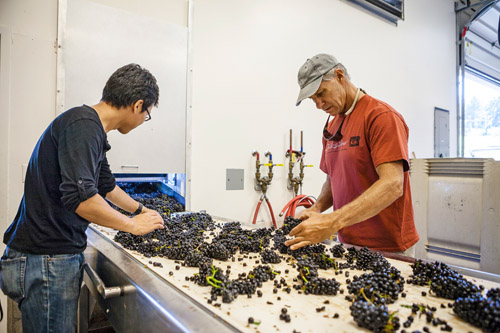 |
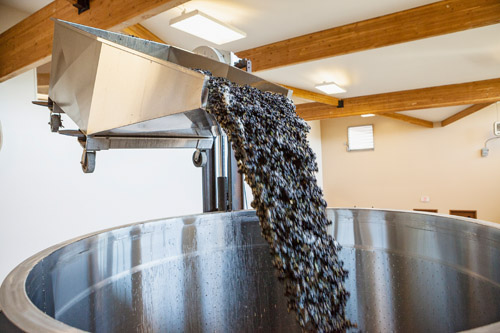 |
 |
| The winemaking process at Trisaetum Winery, where Jadot makes its wine. From top to bottom: The fruit is sorted, then dumped into a vat to ferment. During the fermentation process, juice is drained from the bottom of the vat and pumped back to the top in a process called “pumping over.” |
Yet overall, even Rosback thinks these investments by well-financed outsiders are a good thing. “It’s validation of what our pioneers figured out 40 years ago,” he says.
This is a good outlook to have, since the acquisitions by outside winemakers show no signs of slowing down. In September California music executive Jay Boberg, chairman of digital music provider INgrooves, and Jean-Nicolas Méo of Domaine Meo-Camuzet in Burgundy bought the 13-acre Bishop Creek Cellars vineyard in Yamhill-Carlton. Bouman says a few additional high-profile French winemakers are poking around, and he’s also shown properties to Californian, Italian and even Brazilian buyers. Mike McLain at McLain & Associates Vineyard Properties in Albany confirms the interest from California and abroad, saying his phone is ringing off the hook. “We’re getting a lot of calls from all over!” he says.
And yet the question remains: Can the Willamette Valley make room for these deep-pocketed newcomers while maintaining its unpretentious, laid-back vibe? Or does their arrival signal a shift in the landscape — like the entrance of a shiny new Starbucks that drives up rents and latte prices in its wake?
Gone are the days when a winemaker of modest means could buy land in the Willamette Valley without significant outside investments.
“The water is much deeper than it was 12 years ago when I started,” says Goodfellow. “Your margin for error is less. You have to elevate your game.”
But if you can’t afford a vineyard — or land on which to plant one — then you’re stuck paying $3,500 a ton for pinot noir grapes … at least for a few years. People are planting like crazy right now, according to Goodfellow and others, so prices should come down in three years, when those vineyards start bearing fruit.
Which brings us back to per-bottle prices. The fastest-growing segment of the wine industry is the upper end of the wine market — those that sell for $20 a bottle or more. Plenty of Oregon winemakers already charge $50 or more per bottle. But with grape prices higher than ever — and Jackson Family Wines and other newcomers charging more per bottle — the idealistic Oregon winemakers who want to keep pinots affordable may have to rethink their strategy.
Maybe, just maybe, all these changes in the valley — not to mention the continued drought in California propelling winemakers to move north — will give Oregon winemakers permission to charge a little more for their wine. That would be a boon for Oregon winemakers, if not exactly for consumers.
As for Kevin Chambers: He had planned to farm hazelnuts on his new property in west Salem but can’t shake the grape-growing bug. “This property is crying out to be a vineyard,” he says of his new southeast-facing property, which spans the crown of the Eola-Amity Hills. Once Chambers rips out 62,000 more Christmas trees, he’ll plant grafted rootstock. He intends to sell his grapes to local winemakers. “It’s all cyclical. Prices are very high right now. We’ll see quite a bit of planting over the next five years, and then prices will come down again.”


